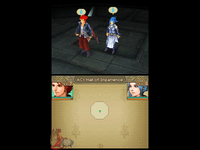|
|

|
PLATFORM
|
DS
|
BATTLE SYSTEM
|

|
INTERACTION
|

|
ORIGINALITY
|

|
STORY
|

|
MUSIC & SOUND
|

|
VISUALS
|

|
CHALLENGE
|
Easy
|
LENGTH
|
Less than 20 Hours
|
|
OVERALL

|
+ Humorous dialogue.
+ Creative puzzles in dungeons.
+ If you die, you can gain five levels!
- Slowdown causes lots of problems.
- Story seems chopped up.
- Controls are sluggish.
|
Click here for scoring definitions
|
|
|
The 16-bit era was home to a ton of great gaming memories, and for many RPGamers, Lufia II: Rise of the Sinistrals was a highlight. More than fifteen years later, Neversoft has returned to bring this title to a new audience with Lufia: Curse of the Sinistrals, now a 3D RPG with real-time action combat. As someone who played the original on the SNES many years ago, I can recall enjoying it well enough, but few specifics, so this won't be a trip down memory lane with me pointing out how Lufia II was better in this way or that. Believe me, Curse of the Sinistrals has enough issues of its own without comparing it to a retro title.
Lufia's story starts off with Maxim, a warrior from the lowly village of Elcid, charging head first into Soma Temple to do battle with Gades, an evil sinistral bent on destroying everything. Maxim is severely outclassed and quickly defeated, but thankfully is saved by a priestess who just happened to be nearby. Upon returning to town, he vows to do all it takes to become stronger and gather new allies to help defeat Gades. This involves traveling to many locations around the world to find new companions, helping out when needed. The story feels very chopped up, as if the developer just took the highlights of the original and crammed them into this title with little attention to rising action, build up, or character development. It's a shame, because the overall plot of the game is fairly interesting with many unique story points, and the localized dialogue from Natsume is humorous, filled with lots of intentionally corny one-liners and side jokes between the characters. Had the story just been fleshed out a little more, it might have had more impact when needed. As is, it just serves as a mechanism to progress from one point to the next with a funny line here and there.
 I agree completely, guys.
I agree completely, guys.
|
|
One area where Lufia II stood out was in its puzzle-centric dungeons, and those have returned here in Curse of the Sinistrals. These areas are filled with platforming-focused puzzles in a 3D environment. It's in these puzzles that Lufia shines, as some of them show signs of brilliance, but are sadly marred by horrible controls and a frustratingly fixed-angle camera. Maxim and crew are sluggish to control when moving or jumping, which is not helped by the large frame rate drops that occur whenever a lot is taking place on the screen. This is made even worse by the camera, which is permanently fixed in a straight ahead view. For areas with 3D environments, this makes it hard to always see where the next place to go is, so players might spend a lot of time jumping, dropping, praying that they land in the right spot The puzzles themselves are not the problem, as those can be quite enjoyable. It's just the interface by which the player is given to solve them that will cause never-ending irritation.
Combat is also a victim of poor controls and bad frame rates. Maxim and his teammates have a variety of attacks which they can perform based on what weapon is equipped, and players can swap between any of the available party members by simply tapping their portrait on the lower screen, one of the few uses of touch controls. In combat, players can also jump and dodge roll out of the way of enemy attacks. The battle system would be more than serviceable if not for a few major issues. It's easy to point to the slowdown as the main culprit, but other issues such as extremely slow recovery time after being knocked down and imprecise angles of attack can also be frustrating.
A few other issues, such as taking damage from falling off a platform and heavy damage from status aliments can at least be countered by the game's mystic stone system. This system allows players to take stones found throughout the world and place them on a tile board in order to activate certain skills or enhancements. This serves as the most effective form of character progression, as equipment upgrades are pretty basic and level does little other than a slight stat boost. Level matters much less than skill and enhancements in this game, so much so that upon dying the player can opt to restart the area with a five level boost. This might seem like it would make the game great deal easier, but without good platforming skills and being able to work around the frustrating controls, increased levels help very little. This is especially true during the game's boss fights, which often have players finding a specific trick in order to win in long, drawn out battles.
 It really should be.
It really should be.
|
|
Lufia's graphics are pretty decent, but offer little variety. That's more a gameplay issue, as the game has players retracing their steps quite often throughout. There are a few impressive cutscenes that show off the visuals, but for other places where the graphics could really shine, such as boss fights, slowdown prevents that, often making the game appear blurry. The music in Curse of the Sinistrals is fairly impressive, but also suffers from overexposure due to excess backtracking. Voice acting is used so sporadically here it's tough to say if it would be missed had it not been included. It doesn't help that the voices are far from outstanding.
While Lufia II on the SNES might have been a rising star, this title is clearly cursed. The game's problems get in the way of enjoying almost everything. The dungeon puzzles could have been great, but are instead hindered by poor design. The story might have been more enjoyable had a little more time and care been spent on developing the characters and plot. Sadly, this game's moments of glory are overshadowed by a variety of problems. While I can't say with a clear enough memory how or if the original Lufia II was better, I can say that sometimes drastic change is not always needed when reviving an older property. And if you're going to tell a story, it's best to use the whole novel, not just the CliffsNotes.
Review Archives
|









